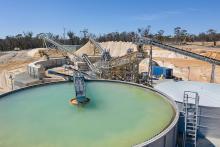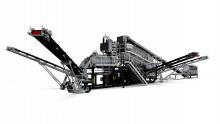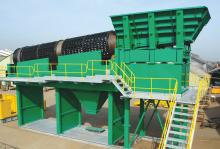A Terex Washing Systems (TWS) 150tonnes/hour recycling wash plant has recently been installed for Paterson’s Quarries in the UK.
The bespoke plant is now up and running ten hours plus each day at the firm’s Greenoakhill Quarry & Recycling Centre in Glasgow. It is processing construction, demolition and excavation waste to produce four grades of stone and two grades of sand.
A
Paterson’s had approached TWS’s Scottish dealers Blue Machinery (Scotland) (BM)as they required a recycling wash plant to deal with tens of thousands of tonnes of construction, demolition and excavation waste. Extensive initial testing and sieve analysis highlighted that the material to be processed had a very high silt content of 30% plus. After consultation with BM and Paterson’s vigorous analysis on the feed product, TWS proposed their range of cyclone separators and utilised a prewash to manage this high level of silt (less than 63 micron material).
“TWS proposed a bespoke system which is now ensuring that the construction and demolition waste material is being effectively processed and is producing saleable aggregates and sand,” said Fergal McPhillips, sales manager for TWS.
With the new Greenoakhill plant, material is first fed to an H9 feeder fitted with a double deck vibrating grid. This initial feed stage is powered by a 22kW electric hydraulic powerpack. The vibrating grid is required to handle the variable sticky material and remove any oversize.
The static 30m lattice main feed conveyor transports material from the variable speed belt feeder to the 165 R screen. The feed conveyor has an over-band fitted to remove ferrous materials via a stainless steel chute to a skip for recycling.
The material receives an initial soaking in a rubber lined wash box before being delivered to the 165 R screen. The 40.64cm x 12.7cm screen is fitted with 5cm polyurethane top deck and split bottom deck of 5mm and 3mm. 5cm oversize is rinsed clean and removed at this stage to be sent to an impact crusher for resizing. Material between 5mm and 5cm is rinsed and continues into a PS 120R. The rinsed fines drop through either the 3 or 5mm polyurethane split bottom deck. The 5mm material is fed directly to the FM 120 C dewatering screen to be dewatered and stockpiled by a TC 4026 conveyor.
The 3mm and under finer material is piped to the prewash where initial clays and silts are floated off to sump tank 1 while heavier sand material drop to the bottom of the prewash to be pumped up into a separator, where again silts and clays are removed in the overflow to sump tank 1. The underflow from the separator then flows into the tank of the FM 120 C. The FM 120 C is fitted with a second separator to which material from the tank is pumped by the centrifugal pump. Overflow is again sent to sump tank 1 while the underflow is delivered to the dewatering screen to be dewatered and stockpiled via a TC 4026 conveyor. The overflows from sump tank 1 are pumped by a vertical shaft pump to the water treatment plant. The water treatment plant currently consists of a flocculent dosing plant, 1cm thickener tank and fresh water.
The 5mm-5cm aggregate sent to the PS 120R is scrubbed clean with any clays and lights floated off through a trough to the integrated DW062 dewatering screen where above 500 micron material is delivered to a skip while fines are delivered to sump tank 2. The scrubbed aggregate exits the PS 120R onto an integrated DW125-2 (30.48cm x 12.7cm) two-deck dewatering screen. The material receives an initial rinse to remove any last remaining grit and film attached to the aggregate. The fines from this rinsing process are washed into a part rinser catchbox and piped to sump tank 2. The DW125-2D screen is fitted with a 2.2cm top deck and split bottom deck of 1cm and 5mm. Three TC 4026 conveyors stockpile the resultant 2.2cm-5cm, 1cm-2.2cm and 5mm-1cm products.
The dirty water sent to sump tank 2 from the two PS screens is then pumped using a vertical shaft pump to the either the 165R screen for reuse or direct to the FM 120C tank. The flow is controlled using a saunders valve.
The end products are being sold into the market for construction projects and groundwork contracts throughout Glasgow as well as being used in Paterson’s Readymix and their concrete block making operations.







